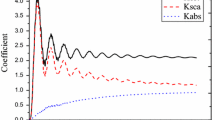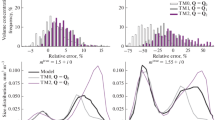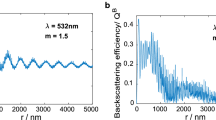Abstract
Aerosols influence the radiation budget of the Earth’s atmospheric system. Aerosol particle size distribution is one of the major parameters used for characterizing aerosol influence on radiative forcing. The optical and microphysical properties of aerosol particles over Yinchuan, China, were measured with a multiwavelength lidar developed at Beifang University of Nationalities using backscatter and extinction coefficients at wavelengths of 1064, 532, and 355 nm. These data were used to retrieve particle size distributions. Given the disadvantages of the traditional regularization method, the innovative multipopulation genetic algorithm (MPGA) was used to retrieve the particle size distribution from the lidar data. To verify the feasibility of using the MPGA on multiwavelength lidar data, experiments were carried out under different atmospheric conditions, including a background sunny day, a cloudy day, and a foggy day. The particle size distributions obtained from the multiwavelength lidar data were compared with results retrieved from direct irradiance data from a sun photometer. Results showed that the MPGA is suitable for retrieving particle size distributions from multiwavelength lidar data.
Similar content being viewed by others
References
A. Shimizu, N. Sugimoto, I. Matsui, and T. Nishizawa, J. Quant. Spectrosc. Radiat. Transfer, 153, 77 (2015).
S. N. Volkov, I. V. Samokhvalov, D. C. Hai, and D. Kim, App. Opt., 54, 3095 (2015).
W. Gong, W. Wang, F. Mao, and J. Zhang, Opt. Commun., 349, 145 (2015).
S. P. Burton, R. A. Ferrare, C. A. Hostetler, et al., Atmos. Meas. Tech., 5, 73 (2012).
D. Müller, D. Althausen, U. Wandinger, and A. Ansmann, “Multiple-wavelength aerosol lidar” in: A. Ansmann, R. Neuber, P. Rairoux, and U. Wandinger (Eds.), Advances in Atmospheric Remote Sensing with Lidar, Springer Verlag, Berlin (1996).
D. Althausen, D. Mülle, A. Ansmann, et al., J. Atmos. Ocean. Technol., 17, 1469 (2000).
D. Mülle, U. Wandinger, and A. Ansmann, Appl. Opt., 38, 2346 (1999).
D. Mülle, U. Wandinger, and A. Ansmann, Appl. Opt., 38, 2358 (1999).
D. Mülle, F. Wagner, U. Wandinger, et al., Appl. Opt., 39, 1879 (2000).
C. S. Hong, K. H. Lee, Y. J. Kim, and Y. Iwasaka, Environ. Monit. Assess., 92, 43 (2004).
H. Parsiani and J. Mendez, WSEAS Trans. Syst., 7, 1218 (2008).
R. E. Mamouri, A. Papayannis, V. Amiridis, et al., Atmos. Meas. Tech., 5, 1793 (2012).
J. Song and H. Zhang, Acta Meteorol. Sinica, 4, 483 (1982).
Z. Tao, Y. Zhang, G. Zhang, et al., Chin. J. Quantum Electron., 21, 103 (2004).
Z. Tao, D. Liu, H. Wei, et al., Spectrosc. Spect. Anal., 33, 1739 (2013).
D. Liu, Z. Tao, D. Wu, et al., Acta Optica Sinica, 33, 0228001-1 (2013).
D. Liu, Z. Tao, Hu ShunXing, et al.. Acta Optica Sinica, 34, 0401001-1 (2014).
W. Wilson and H. Suh, J. Air Waste Manag. Assoc., 47, 1238 (1997).
R. Pozzia, B. De Berardis, L. Paoletti, and C. Guastadisegni, Toxicology, 183, 243 (2003).
T. Chen, Y. Zhao, D. Liu, et al., Chin. J. Lasers, 39, 0514001 (2012).
H. Di, X. Hou, H. Zhao, et al., Acta Physica Sinica, 63, 244206 (2014).
L. Dai, H. Ding, and D. Sun, Semicond. Optoelectron., 29, 980 (2008).
S. N. Sivanandam and S. N. Deepa, Introduction to Genetic Algorithm, Springer Verlag (2007), p. 325.
N. S. Mera, L. Elliott, and D. B. Ingham, Comput. Mech., 33, 254 (2004).
J. Mao and Juan Li, Terr. Atmos. Ocean. Sci., 25, 791 (2014).
J. Mao, H. Sheng, H. Zhao, and C. Zhou, Adv. Meteorol., 2014, 157645 (2014).
Author information
Authors and Affiliations
Corresponding author
Rights and permissions
About this article
Cite this article
Mao, J., Zhao, H., Sheng, H. et al. Particle Size Distributions Based on a Multipopulation Genetic Algorithm Used in Multiwavelength Lidar. J Russ Laser Res 37, 69–81 (2016). https://doi.org/10.1007/s10946-016-9546-z
Received:
Published:
Issue Date:
DOI: https://doi.org/10.1007/s10946-016-9546-z




